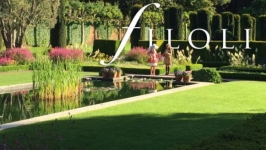Tasting and Touring History at Filoli’s Gentleman’s Orchard
It’s always fun to tour historic mansions and imagine what life was like for the people who lived there. But when can you actually taste what they ate? When can you actually taste history?
That’s exactly what you can do at Filoli’s annual Orchard Day event, when Filoli offers visitors tastes of the apples and pears right from the home’s 100-year-old orchard. Tours of the 6.8-acre “gentleman’s orchard” and samples of over 30 varieties of apples and pears give guests the most tangible way possible to imagine what life was like for the Bourn family, who lived at Filoli from 1917 to 1936.
“Imagine that it’s a dark winter night in 1922 and you’re wishing you had something sweet after dinner,” says Jim Salyards, Filoli’s head of horticulture. “You could have a special treat—an orchard-grown medlar, which tastes like sweet spiced apple sauce. Sip some cognac alongside it and you’d have a most civilized evening ahead.”
But the medlar isn’t a fruit you would eat when fresh. It has to be ripened until almost rotten—a process called “bletting”—to the point that it looks ready for the compost heap. “If it’s not properly blet, it would taste like Band-Aids,” laughs Salyards.
The oddly shaped medlar—a smallish, rosy-rust-colored fruit with what looks like a crown on top—is reminiscent of a rose hip. You won’t be able to sample it at Orchard Day; it doesn’t ripen until December. But there are many others you can try.
There’s Thomas Jefferson’s favorite apple: the Esopus Spitzenburg. It was grown at Jefferson’s Monticello estate in the mid 1700s. Your taste of the Spitzenburg comes from one of the oldest trees in the Filoli orchard—close to 100 years old. According to descriptions, this apple is praised as “one of the most tasty in the world, makes the finest pies, good for eating and also for cider.”
During the tour, you may come across the “Wolf River apple”—described not only as large, but “enormous.” “People used to call it a one-apple pie because they claimed you could make a whole pie out of just one,” said Kate Nowell, Filoli’s garden manager. “It was first grown in Wisconsin in 1881, and people grew it so they could win first prize at county fairs for the biggest apple.”
There’s something else you’ll want to try at Orchard Day – and that’s hard cider. For the first time, Filoli’s horticulturists enlisted a cidermaker in Sebastopol to turn some of the orchard’s bounty into hard cider. Over two and a half tons of fruit was sent to be pressed, fermented and bottled in time for retail sales at Filoli’s Clock Tower gift shop on October 12.
What went into the cider? Many different apples contributed, but one in particular is something you may see on the tour. The Dolgo Crabapple is a small, oblong red apple so tart that a little bite will make you pucker up. But the acidity in the crabapple is crucial to the production of cider. That, along with bitter and sweet apples are needed for a good cider. Fermentation will then build a nice flavorful, but dry cider.
After both William Bowers Bourn II and his wife Agnes Moody Bourn died in 1936, the estate was purchased by Lurline Matson Roth. She donated the property to the National Trust for Historic Preservation in 1975. By 1997, only 150 trees of the 1,000 the Bourns had originally planted in 1918 had survived. The orchard stood mostly untouched for two decades as horticulture at Filoli focused mainly on the formal gardens.
In 1997, Filoli’s horticultural director, Lucy Tolmach, proposed that the orchard be renovated, both to preserve its heritage as an example of American turn-of-the-century estates and to conserve diverse genetic characteristics—or germplasm—of the heirloom fruit. If historic genes were lost, many centuries of plant breeding would also be lost.
Working with experts in heirloom fruit such as C. Todd Kennedy, the Santa Clara Chapter of the Rare Fruit Growers and others, a new collection of 225 historic apple and pear trees was planted. Today, over 577 apple and pear trees grow in the orchard, including 114 trees planted by Bourn.
You can take a piece of the orchard home with you in the form of apple and pear butters for sale in the gift shop. “If we have a big enough quantity, we make apple butter from a single variety, like the Esopus Spitzenburg currently in the store,” says Salyards. “We also make heirloom apple butter out of a mixture of apples from the orchard. Our pear butter is really popular—people love that one and it sells out quickly every year.”
Not all of the fruit goes into butters, however. During harvest, about 150 pounds of apples are picked every week for eight weeks for St. Anthony’s Padua Dining Room in Menlo Park. The biggest harvest comes at the end of the season when Village Harvest volunteers pick between 1,000 and 2,000 pounds of apples for the Second Harvest Food Bank.



